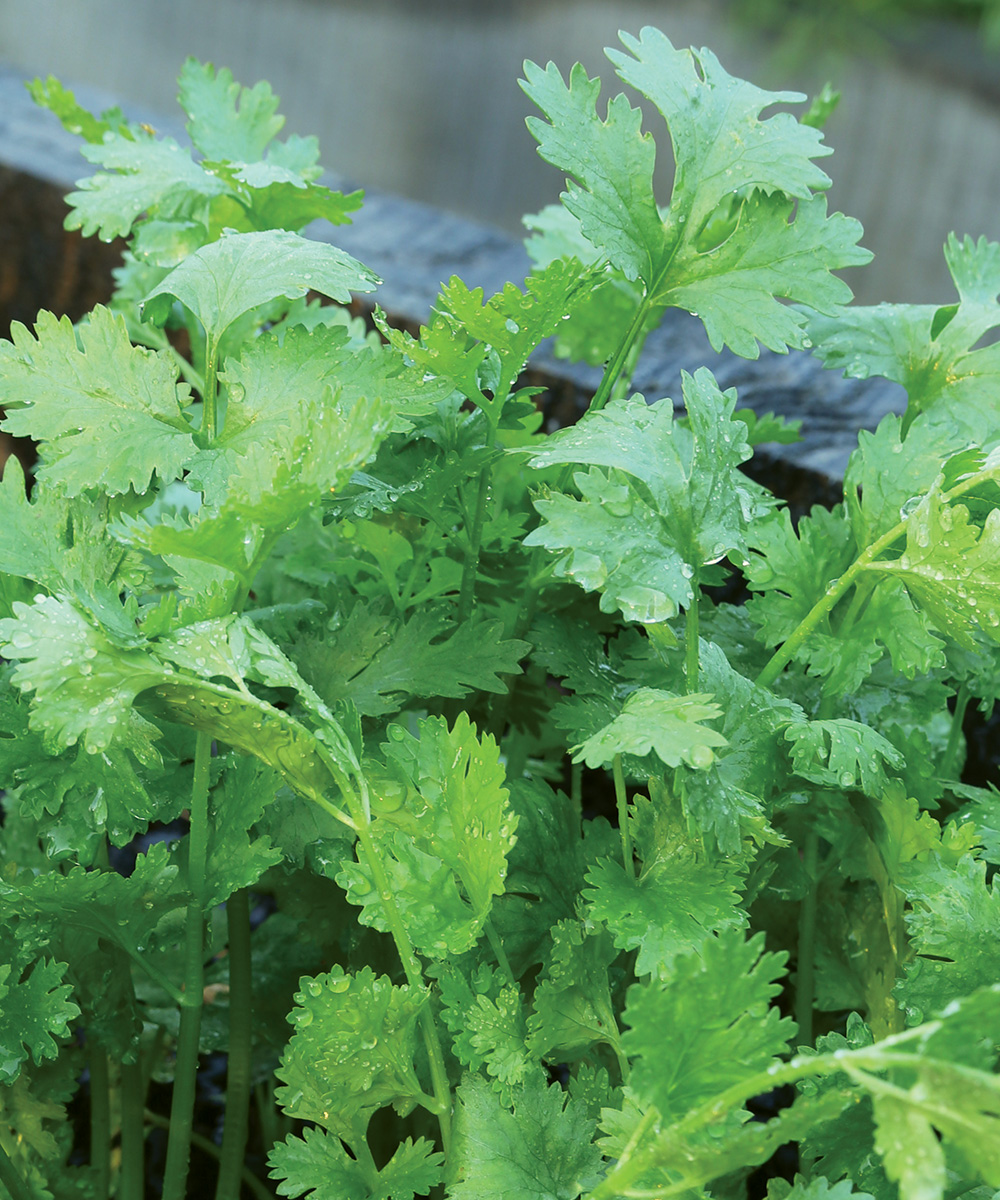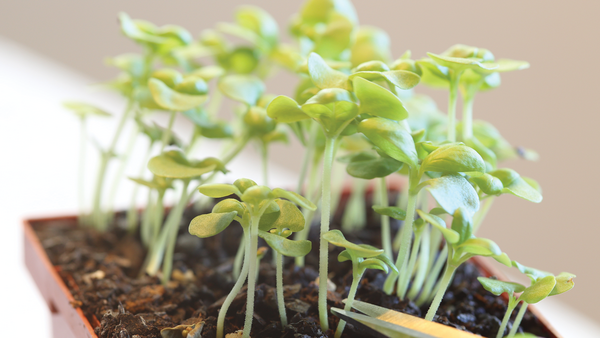
Herbs are powerful plants. Just the thought of picking fresh rosemary (Salvia rosmarinus spp. and cvs., Zones 8–10) or basil (Ocimum basilicum spp. and cvs., annual) can awaken our sense of smell or conjure up memories. For thousands of years, humans have used herbs not only for cooking but also for medicinal, therapeutic, and spiritual purposes. Their aromatic qualities make them generally immune to insect and critter damage, and when they bloom, their flowers are alluring for pollinators. I like to think of herbs as the elders in the garden that bring great usefulness and beauty.
But purchasing plant starts in 4-inch pots for herb gardening is often a pricey endeavor—as is buying a fresh bundle of an herb from the grocery store when you only need a few sprigs. Growing herbs from seed can save time and money, allowing you to grow even more plants for less. Plus, whatever you don’t need can be dried for later use. The next time you plan to add some herbs to your garden menu, consider these great choices that can easily be grown from seed without requiring chilling, scarifying, or any other seed-starting treatment. Learn more: 6 Tips to Successfully Grow Herbs Inside Year-Round
Start these indoors for faster maturity
While patience is an important quality to have when gardening, knowing how to fast-track to an earlier harvest is a valuable skill too. Because these herbs take longer to mature (and sometimes to germinate), it’s best to get a jump on the season by starting them early indoors, especially in cooler climates.

Give parsley seeds extra time for a full season of culinary use
Name: ‘Giant of Italy’ flat leaf parsley (Petroselinum crispum ‘Giant of Italy’)
Zones: 5–9
Size: 24 to 36 inches tall and 18 to 24 inches wide
Conditions: Full sun to partial shade; well-drained soil
Days to germinate: 14 to 30
Days to maturity: 75
Planting: Sow seeds indoors 6 weeks before your preferred spring transplanting date.
‘Giant of Italy’ parsley is a large, upright variety with many culinary uses. Its size makes it best suited for the garden, while more compact varieties such as ‘Titan’ work better in containers. Parsley can be slow to germinate, which is why I prefer to start it indoors. If you choose to sow it directly in the garden, do so as soon as possible in early spring. Parsley is a biennial and often reseeds itself in warmer climates. Its flowers and even its leaves attract and support beneficial insects.

Add a touch of tranquility to the garden and your favorite tea
Name: German chamomile (Matricaria recutita)
Zones: Annual
Size: 8 to 24 inches tall and 8 to 12 inches wide
Conditions: Full sun; average, fertile soil
Days to germinate: 10 to 14
Days to maturity: 75
Planting: Start seeds indoors 4 weeks before the last frost.
German chamomile is a fast-growing annual that often reseeds itself from year to year. Its tiny daisy-like flowers have been used in teas and tinctures since antiquity for a variety of therapeutic benefits, but most commonly to help support sleep. Once planted in the garden or in pots, chamomile is a profuse bloomer. Because just the flower heads are used for tea and not the stems, harvesting can be time-consuming, but having your own supply of dried chamomile from the garden is rewarding. Flowers may be steeped fresh, or dried and stored for later use. If you don’t have a dehydrator, you can spread the flowers on a screen or a baking sheet and place them in a warm, dry place indoors for a few days and then store them in an airtight jar. If you prefer, German chamomile seeds can also be sown directly in the garden in spring through early summer.

An ancient Mediterranean herb that offers one-of-a-kind flavor
Name: Syrian oregano (Origanum syriacum)
Zones: 7–11
Size: 12 to 24 inches tall and wide
Conditions: Full sun; slightly dry soil
Days to germinate: 7 to 14
Days to maturity: 85
Planting: Start seeds indoors 4 to 6 weeks before the last frost.
This herb can be found under a myriad of common names, including Syrian oregano, zaatar, Bible hyssop, and sometimes even sweet marjoram—though don’t confuse it with Origanum majorana, which is an entirely different plant. This Mediterranean herb has a flavor similar to that of oregano, but it is milder and has a bit more complexity. Due to its delicate and subtle flavor profile, it works well when added to dishes toward the end of cooking or as a garnish. In a variety of ancient cultures, plants within the Origanum genus had mythological, ritual, and medicinal significance. Syrian oregano can be direct-sown after danger of frost, but because it grows slowly it will be more successful if started early indoors.

These edible petals provide a splash of color in containers and summer salads
Name: ‘Strawberry Blonde’ calendula (Calendula officinalis ‘Strawberry Blonde’)
Zones: Annual
Size: 12 to 20 inches tall and wide
Conditions: Full sun; fertile soil
Days to germinate: 7 to 14
Days to maturity: 80
Planting: Sow seeds indoors 4 to 6 weeks before the last frost date.
Calendula is commonly used in vegetable gardens, along with other flowering plants such as nasturtium (Tropaeolum majus spp. and cvs., annual), marigold (Tagetes spp. and cvs., annual), and borage (Borago officinalis, annual) to draw in pollinators and add a splash of color. It also works well in containers. Calendula is revered for its anti-inflammatory, astringent, antimicrobial, and antifungal healing properties; its petals are a common ingredient in natural skin-care products and can easily be used to make home-made salves. The edible petals can also be sprinkled on a summer salad or used as a beautiful garnish. Among my favorites is ‘Strawberry Blonde’ calendula, a creamy-pink selection that is less common than its orange and yellow relatives. The claw-shaped seeds can also be direct-sown a few weeks before the last frost date.

This pollinator magnet has wonderfully aromatic leaves
Name: Lemon balm (Melissa officinalis)
Zones: 3–7
Size: 18 to 26 inches tall and 12 inches wide
Conditions: Full sun; moist, well-drained soil
Days to germinate: 7 to 14
Days to maturity: 70
Planting: Sow seeds indoors 6 to 8 weeks before the last frost date.
Most commonly used as a tea, this herb is known for its many benefits, including as a sedative, antiviral, and digestive. Its aromatic qualities are strongest when the leaves are fresh, but it is easy to dry for later use. Like most other herbs, lemon balm brings in pollinators when it blooms and readily spreads in the garden when it finds a spot where it is happy. The tiny seeds must be just barely covered with soil when sown indoors or out, as light is needed for germination. Starting seeds early indoors is advisable, however, to allow for more substantial growth in the first season.

There’s no such thing as too much basil
Name: ‘Genovese’ basil (Ocimum basilicum ‘Genovese’)
Zones: Annual
Size: 20 to 24 inches tall and 10 to 14 inches wide
Conditions: Full sun; moist, rich, well-drained soil
Days to germinate: 5 to 10
Days to maturity: 68
Planting: Start seeds indoors 4 to 6 weeks before the last frost date. Follow with subsequent direct sowings after the danger of frost has passed.
Basil, and in particular the cultivar ‘Genovese’, is one of the most well-loved and widely used fresh herbs. When it is paired with fresh sliced tomato, blended into fresh pesto, or added to tomato sauce, its classic Mediterranean flavor makes it an iconic kitchen garden herb. Although it will hold in the garden longer than other herbs and can be pinched back to encourage new growth, it eventually burns out and can be susceptible to blight. Direct-sowing every 3 to 4 weeks throughout the warmest months will ensure a continual supply.

A must-have herb that serves up culinary delight
Name: ‘Bouquet’ dill (Anethum graveolens ‘Bouquet’)
Zones: Annual
Size: 24 to 36 inches tall and 12 to 18 inches wide
Conditions: Full sun; fertile, well-drained soil
Days to germinate: 7 to 21
Days to maturity: 55
Planting: Start seeds indoors 4 to 6 weeks before the last frost date. Follow with subsequent direct sowings after the danger of frost has passed.
Dill is a critical herb in the kitchen garden of anyone who loves classic summer dishes such as grilled fish, potato or cucumber salad, and homemade pickles. When a recipe calls for fresh dill, it is very rewarding to have it on hand. I especially like ‘Bouquet’, which is known for producing high yields of useful leaves and seeds. Easy to direct-sow, these feathery plants quickly stretch up and flower, making succession planting important if you wish to have a continuous supply. Sowing a cluster of seeds every 3 to 4 weeks should do the trick. If you have enough space to allow the older dill plants to bloom, their large, bright yellow flowers will support pollinators and beneficial insects. Dill often reseeds itself in the garden from year to year, but its seeds can also be saved easily for planting.

Creative dishes are just a snip away with this savory herb
Name: ‘Leisure’ cilantro (Coriandrum sativum ‘Leisure’)
Zones: Annual
Size: 24 inches tall and 8 to 12 inches wide
Conditions: Full sun; loose, well-drained soil
Days to germinate: 7 to 10
Days to maturity: 55
Planting: Sow seeds indoors 4 weeks before your preferred spring transplanting date. Follow with subsequent direct sowings from spring to fall.
Fresh cilantro is used in Middle Eastern, Thai, Indian, East Asian, and Mexican dishes, and inventive recipes for cilantro pesto have become popular in recent years. Cilantro is also said to have many health-enhancing benefits. While it is easy to grow, it stretches upward fairly quickly into delicate flowers that the bees love. The flowers turn to seed (coriander), which can be collected easily for future planting. This herb grows well and holds better in cooler weather. ‘Leisure’ is one of my favorite selections because it bolts slower than other varieties. Even so, direct-sowing seeds every 3 weeks will ensure a steady supply from spring to fall.
Erin Walrath-Mariano is a hands-on kitchen garden expert with more than 17 years of professional experience designing, building, and maintaining private kitchen gardens in Connecticut and New York.
Sources:
- High Mowing Organic Seeds, Wolcott, VT; 866-735-4454; highmowingseeds.com
- Johnny’s Selected Seeds, Fairfield, ME; 877-564-6697; johnnyseeds.com
- Baker Creek Heirloom Seeds, Mansfield, MO; 417-924-8917; rareseeds.com


















Comments
Log in or create an account to post a comment.
Sign up Log in